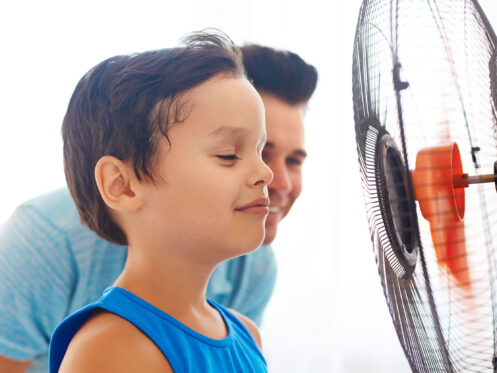With its high heat and humidity, San Antonio, TX, is no place to be without a functional air conditioner. Your AC should reliably produce and distribute chilled air while simultaneously extracting excess moisture. If the interior of your home feels warm, muggy, or oppressive, there’s a problem. More often than not, these conditions are paired with pooling water. Read on to learn why AC leaks occur and how to fix them.
Common Causes of AC Leaks
Air conditioners can leak as a result of insufficient maintenance, ongoing wear, or poor installation. Refrigerant leaks and frozen evaporator coils are common causes of AC leaks. However, if you have standing water around your indoor air handling unit, the most likely culprit is a blocked or damaged condensate drain line.
What Your AC Condensate Drain Is and What It Does
Typically made of copper or white PVC, the condensate drain line is a slim pipe that travels from under your evaporator coil to the exterior of your home. Your AC condensate drain exits at the exterior wall that abuts your outdoor condenser unit.
Just beneath your evaporator coil, you’ll find a shallow drain pan as well. This pan collects excess water to prevent overflows, pooling water, and moisture-related building damage whenever condensation moves slowly or drain line blockages exist. Modern air conditioners also have wet switches in their drain pans. These switches detect rising moisture caused by blockages and turn systems off to prevent additional problems.
During each cooling cycle, cold refrigerant travels to your indoor air handling unit as a frosty liquid. Your air conditioner passes warm indoor air over its evaporator coil, and the cold refrigerant inside this coil extracts the heat and humidity from the air. The refrigerant is then funneled to the outdoor condenser unit as a hot, high-pressure gas while shedding its heat and humidity along the way.
As gaseous refrigerant is compressed, it returns to its liquid state, and the resulting condensation enters the AC condensate drain line. This moisture exits your home via the condensate drain.
Why Condensate Drain Lines Leak
The most common cause of a leaky condensate drain line is insufficient maintenance. During annual AC maintenance, our technicians flush and sanitize drain lines while checking for rust and other evidence of advanced wear. If you skipped routine maintenance this cooling season, your condensate drain line could be blocked by debris.
Cracked Condensate Drain Lines
Condensate drain pipes can crack due to improper installation, age-related wear, and substandard operating conditions. Weather-related temperature fluctuations and heavy blockages can also cause these components to fail.
Faulty Drain Line Installation
If you recently replaced your air conditioner and have water accumulating around your indoor air handler, your HVAC technician may have improperly installed the drain line. Both drain lines and drain pans must be installed with a sufficient slope. Sloping ensures that water is always moving toward the exterior drain rather than collecting in the drain pan and overflowing.
Rust and Corrosion
Stagnant and slow-moving water in condensate drain lines can eventually lead to rusting in metal components. This and other age and wear-related corrosion can cause leaks and pooling water even when drain lines are clear, adequately sloped, and otherwise working as they should.
Biofilms and Algal Blooms
When you turn your air conditioner off at summer’s end, it often has small amounts of residual water in its drain line. This moisture creates the ideal conditions for mold, bacteria, and algae. As air conditioners lie dormant throughout the winter months, these growths can create a thick, viscous slime in the condensate drain. Pre-season maintenance will clean this slime out. However, when homeowners neglect pre-season AC tune-ups, algal blooms, biofilms, and other build-ups inhibit the flow of water.
Dirt and Other Debris
In addition to mold, bacteria, and algal blooms, dirt, pollen, and other airborne debris could find their way into your condensate drain. These particulates serve as a source of food for mold and other organisms. They can cause blockages on their own or support robust bacterial colonies.
Signs You Have a Dirty or Damaged Condensate Drain Line
Pooling water isn’t the only symptom of a blocked condensate drain. When air conditioners have difficulty releasing the moisture they’ve extracted, building interiors tend to feel damp, clammy, and muggy. Given that wet, humid air often feels much hotter than dry air, the interior of your home could feel a lot warmer as well.
If left unchecked, a dirty or damaged condensate drain can also fill your home with rank, moldering odors. This is especially true if your drain line blockage is the result of excess algae and bacterial growth.
How Condensate Drain Problems Can Affect Your Home
You should address a dirty, blocked, or leaky condensate drain line right away. In addition to diminishing your home comfort and creating unpleasant odors, this problem can drive up your cooling costs. Your AC will have to work harder and longer to create semi-comfortable conditions. Not only will it use more energy in the process, but it can also develop stress-related problems like short cycling and overheating.
When air conditioners short-cycle, they turn on and rapidly cycle back down before they have the chance to lower indoor temperatures. Short cycling is a sign that your AC condensate drain line’s wet switch is registering higher than normal water levels. If your AC shuts off and refuses to turn back on, you may have a more serious drain line blockage that’s preventing water from exiting at all.
Having excess moisture in your indoor air can set the stage for progressive mold issues. If you continue using your AC without resolving the problem, you’ll eventually have wet, condensation-covered drywall and windows, dark patches of mold on porous surfaces, and other mold-related concerns.
Excess moisture can additionally lead to warped furnishings, floorboards, and sub-floors. Pooling water around your air handler can damage nearby wood elements as well.
What to Do If Your AC Condensate Drain Is Leaking
Prevention is always the cheapest way to deal with potential condensate drain line issues. You can avoid most condensate drain blockages and overflows by scheduling a comprehensive AC tune-up service each year. Although there are minor maintenance tasks that many homeowners can capably manage on their own, a professional tune-up will ensure that your drain line is clear, clean, and able to handle summer demands.
If you have excess humidity indoors, pooling water on your floors, and recurring functional problems like short cycling or overheating, schedule AC repair service. Our technicians will inspect your drain line for rust, algal blooms, and other common issues. We’ll help you find a cost-effective and lasting solution. With expert drain line cleaning, we’ll restore your cooling system to optimum levels of performance and efficiency.
Why You Shouldn’t Repair Your Own AC Condensate Drain
Whether blocked, rusted, or cracked, you should never attempt to repair your own AC condensate drain. Doing so could void your AC manufacturer’s warranty and cause more problems than it solves. It’s always best to give your air conditioner the model-specific care it deserves by hiring a reputable HVAC contractor instead.
The Pros Are Here to Help
We help homeowners in San Antonio maintain high-functioning cooling systems. We offer expert AC maintenance, repair, and installation services. We also provide comprehensive drain line cleaning. To learn more about caring for your AC condensate drain or schedule an appointment, contact Air Authority, A Riteway Service Company today!





